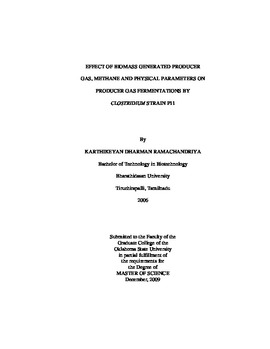| dc.contributor.advisor | Wilkins, Mark R. | |
| dc.contributor.author | Ramachandriya, Karthikeyan Dharman | |
| dc.date.accessioned | 2014-02-25T00:21:11Z | |
| dc.date.available | 2014-02-25T00:21:11Z | |
| dc.date.issued | 2009-12-01 | |
| dc.identifier.uri | https://hdl.handle.net/11244/7962 | |
| dc.description.abstract | The effect of producer gas generated by gasification of Kanlow switchgrass was determined to investigate the robustness of Clostridium strain P11 for the integration of gasification-fermentation process in a lab scale. Further experiments were performed for determining the effect of 5% methane, as methane is a major component of producer gas generated through gasification. Effect of 1.63% oxygen that was present in corn gluten feed (CGF) producer gas was also determined. Furthermore, the effect of physical parameters such as heat shocking, agitation and headspace gas (amount of available gas) were determined for enhancing the solvent concentrations and productivities. Findings and Conclusions: The use of switchgrass producer gas generated from fluidized bed gasifier showed an increase in ethanol concentrations by 125%, decrease in acetic acid concentrations by 40% and production of isopropanol at concentrations as high as 3.9 g/l. Producer gas components such as tars, nitric oxide and hydrocarbons could possibly be responsible for the metabolic shifts. 5% methane did not affect growth, product formation and gas uptake in P11 fermentation indicating that methane was an inert component of producer gas. However, the presence of 1.63% oxygen was highly toxic to P11 cells as it inhibited growth, product formation and gas uptake rates. Also, acetone that was used in gas-clean up was found to be contaminant of producer gas in the CGF experiment as it was getting accumulated in the culture media. Increasing agitation rates inhibited product formation possibly due to the shear sensitivity of P11. Heat shocking at 92�C improved the percentage of gas (CO and H 2 ) utilization, yields of ethanol and acetic acid, ethanol productivity when compared to cells that were heat shocked at 75�C and the cells that were not heat treated. By increasing the headspace gas, cell mass and ethanol concentrations increased by 160% and 181% respectively and the ethanol productivity increased by 865% when compared to the cells that were grown with the normal headspace. | |
| dc.format | application/pdf | |
| dc.language | en_US | |
| dc.publisher | Oklahoma State University | |
| dc.rights | Copyright is held by the author who has granted the Oklahoma State University Library the non-exclusive right to share this material in its institutional repository. Contact Digital Library Services at lib-dls@okstate.edu or 405-744-9161 for the permission policy on the use, reproduction or distribution of this material. | |
| dc.title | Effect Of Biomass Generated Producer Gas, Methane And Physical Parameters On Producer Gas Fermentations By Clostridium Strain P11 | |
| dc.type | text | |
| dc.contributor.committeeMember | Huhnke, Raymond L. | |
| dc.contributor.committeeMember | Bellmer, Danielle D. | |
| dc.contributor.committeeMember | Fathepure, Babu | |
| osu.filename | Ramachandriya_okstate_0664M_10719.pdf | |
| osu.college | Engineering, Architecture, and Technology | |
| osu.accesstype | Open Access | |
| dc.description.department | Biosystems and Agricultural Engineering | |
| dc.type.genre | Thesis | |
| dc.subject.keywords | fermentation | |
| dc.subject.keywords | gasification | |
| dc.subject.keywords | producer gas | |
